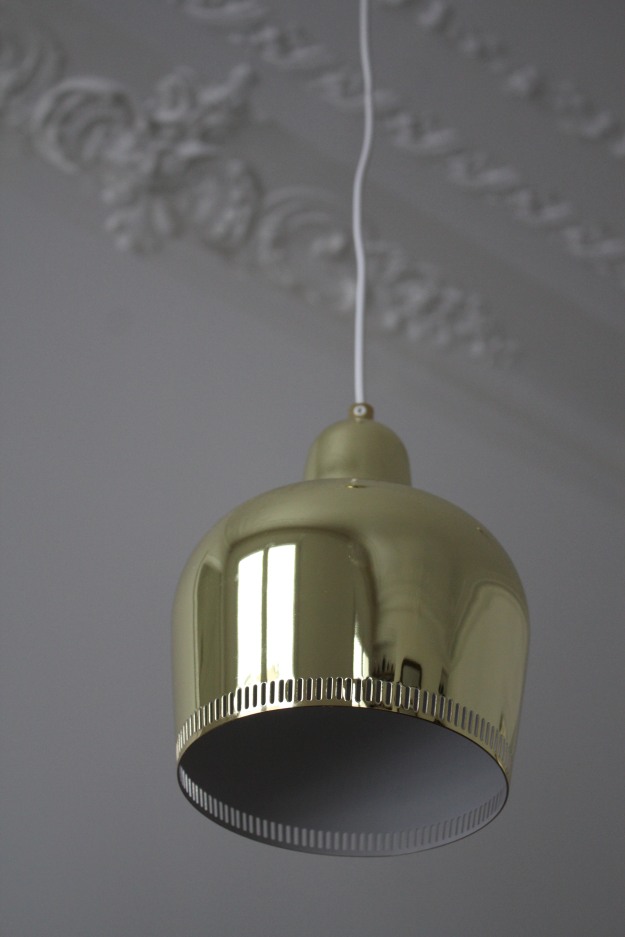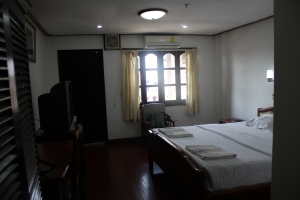My first contact to Laotian food took place in Paris many years ago, at a restaurant called Rouammit in the 13th arrondissement. The same owners nowadays have three restaurants on the same street and since they opened Lao Lane Xang 2, we have been going to this one (http://www.viamichelin.com/web/Restaurant/Paris_13-75013-Lao_Lane_Xang_2-233365-41102). We usually go there at least once a month and in my opinion it is one of the best restaurants in Paris, and I am not only talking about the Asian food category. Needless to say, I was excited to take a cooking class in Luang Prabang to learn more about the culinary culture in Laos. A country that has exported such an excellent restaurant to Paris must have a lot to offer, I figured! 
We chose to have our first Luang Prabang lunch at Tamarind, a restaurant our friend who knows what good food means had recommended to us (http://www.tamarindlaos.com/). The lunch was so tasty that I had no more hesitations about where to do my cooking class, so I booked myself into a one-day cooking class for the next Saturday (classes fill up fast, so book in advance by email!).
Just before 9 o’clock on a Saturday morning everyone met at Tamarind, from where we were taken to a market to learn about the local ingredients. From the market we moved to a beautiful, green setting a bit outside the town, where the culinary secrets were about to be revealed to us.
We started preparing Jeow Mak Keua (eggplant dip). The fact that the ingredients (egg plant, onion, garlic and chillies) were grilled on an open fire gave the dip a smoky taste, and the peeling easier. (The moist should come out while the eggplant is being grilled, so don’t forget to puncture it beforehand!) After peeling these grilled ingredients I pounded them together with coriander, salt and fish sauce in a mortar (a stone bowl). When the paste became soft, our breakfast was ready: apparently Laotians like to eat sticky rice with this dip! So, the next time you fancy a break from your daily croissant or cereal, you know what to do… and you may even not need coffee to wake you up afterward!
plant, onion, garlic and chillies) were grilled on an open fire gave the dip a smoky taste, and the peeling easier. (The moist should come out while the eggplant is being grilled, so don’t forget to puncture it beforehand!) After peeling these grilled ingredients I pounded them together with coriander, salt and fish sauce in a mortar (a stone bowl). When the paste became soft, our breakfast was ready: apparently Laotians like to eat sticky rice with this dip! So, the next time you fancy a break from your daily croissant or cereal, you know what to do… and you may even not need coffee to wake you up afterward!
The next dish we prepared is called Mok Pa (fish steamed in banana leave). In Cambodia it is called amok, and I have seen t his dish (with different name variations) in almost all Southeast Asian restaurants I have been to.
his dish (with different name variations) in almost all Southeast Asian restaurants I have been to.
In a mortar I pounded 1 teaspoon of sticky rice powder, 3 shallots, 1 spring onion, 1 kaffir leave, 2 chillies, 5 thin slices of lemongrass, a bunch of dill and basil, plus a pinch of salt. A generous amount of fish sauce helped the pounding. The next step was to place banana leaves on a fire for few seconds (it makes them softer and more flexible to work with). I then cut the fish into rather large chunks and mixed them with the paste. Lastly, I placed the fish chunks on the banana leaves and folded and tied the leaves (use toothpick to close your banana leaf packages). These packages were then steamed. The next time my father says he has caught too much fish and doesn’t know what to do with the quantity, I tell him to surprise my mother with Mok Pa.
One of the highlights of our lunch at Tamarind a few days earlier had been Oua Si Khai (stuffed lemongrass) so I was pleased to hear it was part of our cooking class program. A s with the previous dish, we started with the mortar and pestle: pound 2 cloves of chopped garlic, 4-5 chopped spring onions, coriander to your taste, 2 kaffir leaves and salt (apparently the blender won’t release the flavors as well as the mortar and pestle). I chose to stuff my lemongrass with chicken and added the minced chicken meat to the paste, but only the imagination is your limit (try fish, shrimps, beef, tofu, vegetables, etc).
s with the previous dish, we started with the mortar and pestle: pound 2 cloves of chopped garlic, 4-5 chopped spring onions, coriander to your taste, 2 kaffir leaves and salt (apparently the blender won’t release the flavors as well as the mortar and pestle). I chose to stuff my lemongrass with chicken and added the minced chicken meat to the paste, but only the imagination is your limit (try fish, shrimps, beef, tofu, vegetables, etc).
Before I could stuff the lemongrass with the chicken paste, I had the most difficult task to accomplish: cut the lemongrass! Actually I will copy paste the instructions from Tamarind, Restaurant & Cooking School, Exploring Lao Cuisine leaflet we were given in the end of our class, as t he cutting technique is quite challenging. “Using a sharp knife, and starting about 1cm from the base of the lemongrass, make a cut right through the stalk for about 4-5 cm, ensuring that both ends of the stalk remain intact, as these ends hold the filling in place. Rotate the lemongrass stalk a quarter turn and repeat. This will give a central hole or cage to hold the filling.”
he cutting technique is quite challenging. “Using a sharp knife, and starting about 1cm from the base of the lemongrass, make a cut right through the stalk for about 4-5 cm, ensuring that both ends of the stalk remain intact, as these ends hold the filling in place. Rotate the lemongrass stalk a quarter turn and repeat. This will give a central hole or cage to hold the filling.”
I managed the cutting part quite ok and after one missed attempt, the chicken paste entered the lemongrass rather neatly. Before I could fry my oua si khai, I dipped them in beaten egg. I asked the chef why we cannot add the egg directly to the chicken paste, but he said the stuffing part will become very slippery (maybe I will try it anyhow one day).
directly to the chicken paste, but he said the stuffing part will become very slippery (maybe I will try it anyhow one day).
I would definitely like to prepare stuffed lemongrass in Paris, too, but my only concern is where to find such large lemongrass?
While our stuffed lemongrasses were left to cook in the frying oil, we moved onto the last dish: laap. I cannot over emphasize my love for laap (sometimes also written larb) –it is one of my favorite dishes in the entire world. This minced meat (or fish) salad, a national dish of Laos, has several variations, but one of the most common variation comes with beef. We followed the tradition and started putting ingredients together in a bowl.


First we put together everything that you can see on the left-side board (minced beef meat, sticky rice powder, chilli powder, salt and fish sauce) and cooked it on a frying pan during few minutes. Secondly and separately, we finely chopped and mixed garlic, shallot, lemongrass, galangal (Lao tian ginger), chillies, (Chinese) long bean, mint, saw tooth, coriander, banana flower and spring onion (the right-hand board). In the end I added beansprouts and lime juice. For the adventurous ones, there was beef bile duct juice to make it more Laotian. In the end I only had to mix the ingredients of these two bowls, place the laap on salad leaves, and voila, my very first laap was ready!
tian ginger), chillies, (Chinese) long bean, mint, saw tooth, coriander, banana flower and spring onion (the right-hand board). In the end I added beansprouts and lime juice. For the adventurous ones, there was beef bile duct juice to make it more Laotian. In the end I only had to mix the ingredients of these two bowls, place the laap on salad leaves, and voila, my very first laap was ready!
It was around 2 o’clock and we had made the eggplant dip and three main dishes. It was time to sit down at the table and enjoy the results of this pleasant day. I liked the crispiness of the chicken-stuffed lemongrass and I  found the laap very good and subtle, and various herbs made it taste very fresh and aromatic. Banana leaf package was intact and I was pleased with my folding skills. It was maybe the least tasty dish, but at the same time it compensated for the tanginess of the laap. And when I felt like something more pungent, I had the eggplant dip.
found the laap very good and subtle, and various herbs made it taste very fresh and aromatic. Banana leaf package was intact and I was pleased with my folding skills. It was maybe the least tasty dish, but at the same time it compensated for the tanginess of the laap. And when I felt like something more pungent, I had the eggplant dip.
Overall, the day was excellent. Our chef was professional, explained with patience and took time to show cutting techniques in person when needed. Tamarind also organizes an evening course where you do one dish less and there is no market visit, but otherwise it is a convenient choice for those limited with time.

 I believe that the version made by Lao Lane Xang 2 is as close as it gets to any lap made in Laos and if you like raw or semi-raw meat, go for it! (Tip: I order lap even during summer months and I have never been sick at Lao Lane Xang 2. But if you hesitate, ask them to cook it more for you)
I believe that the version made by Lao Lane Xang 2 is as close as it gets to any lap made in Laos and if you like raw or semi-raw meat, go for it! (Tip: I order lap even during summer months and I have never been sick at Lao Lane Xang 2. But if you hesitate, ask them to cook it more for you)





























































